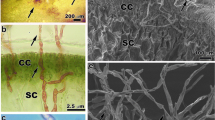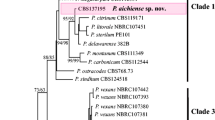Abstract
A newly identified bacterial disease of kelp (Saccharina japonica) gametophytes was found in clone cultures. It is characterized by swollen gametophyte cells in the early period of infection followed by filamentous fading. An alginolytic marine bacterium referred to as A-1 was isolated from the diseased gametophytes. On the basis of 16S rDNA sequencing and morphological, physiological and biochemical characteristics, the bacterium was identified as a strain of the genus Alteromonas. By testing Koch’s postulates, Alteromonas sp. A-1 was further confirmed as the pathogen. The infection process was also investigated using both scanning electron and light microscopy.
Similar content being viewed by others
References
Alker A P, Smith G W, Kim K. 2001. Characterization of Aspergillus sydowii (Thom et Church), a fungal pathogen of Caribbean sea fan corals. Hydrobiologia, 460: 105–111.
Altschul S F, Madden T L, Schaffer A A et al. 1997. Gapped BLAST and PSI-BLAST: a new generation of protein database search programs. Nucleic Acid Rese a rch, 25: 3 389–3 402.
Ando Y, Inoue K. 1965. Decomposition of alginic acid by microorganisms-VI. on the modes of action of two alginases. Nippon Suisan Gakkaishi, 31: 552–557.
Andrews J H. 1976. The pathology of marine algae. Biological Reviews, 51(2): 211–252.
Dimitrieva G Y, Dimitriev S M. 1996. Symbiotic microflora of the brown algae from the genus Laminaria as a bioindicator of the ecological state of coastal Laminaria biocoenoses. Marine Biology, 22: 300–305.
Ding M L. 1990. Effect of environmental factors on alginic acid decomposing bacteria leading to disease and decay of kelp. Acta Oceanol Sinica, 12(2): 224–229. (in Chinese with English abstract)
Ezura Y, Yamamoto H, Kimura T. 1988. Isolation of a marine bacterium that produces red-spots on the culture bed of makonbu Laminaria japonica cultivation. Nippon Suisan Gakkaishi, 54: 665–672. (in Japanese)
Fan X L, Wang, G C, Li D M et al. 2008. Study on early-stage development of conchospore in Porphyra yezoensis Ueda. Aquaculture, 278: 143–149.
Fang Z D. 1998. The Methods of Plant Disease. Agricultural Press of China, Beijing. 62p. (in Chinese)
Holt J G, Krieg N R, Sneath P H A et al. 1994. Gram-negative aerobic microaerophilic rods and cocci. In: Bergey’s Manual of Determinative Bacteriology, 9th edn. Williams & Wilkins. Baltimore. p.71–174.
Ivanova E P, Bowman J P, Lysenko A M et al. 2005. Alteromonas addita sp. nov. International Journal of Systematic and Evolutionary Microbiology, 55: 1 065–1 068.
Leifson E. 1963. Determination of carbohydrate metabolism of marine bacteria. Journal of Bacteriology, 85: 1 183–1 184.
Li W, Zhang T Y, Tang X X et al. 2010. Oomycetes and fungi: important parasites on marine algae. Acta Oceanologica Sinica, 29(5): 74–81.
Li Y X, Wang G C, Xu P et al. 2008. Induction and characterization of green pigmentation mutant in Porphyra yezoensis Ueda. Aquaculture, 282: 117–123.
Liu T, Cui J J, Yang Z et al. 2001. Effect of alginic acid decomposing bacteria on Laminaria japonica cloning gametophyte and its medicine control. Marine Fisheries Research, 22(3): 50–54. (in Chinese)
Mu R M, Fan Z Q, Pei H Y et al. 2007. Isolation and algaelysing characteristics of the algicidal bacterium B5. Journal of Environmental Sciences, 19: 1 336–1 340.
Oppenheimer C H, ZoBell C E. 1952. The growth and viability of sixty-three species of marine bacteria as influenced by hydrostatic pressure. Journal of Marine Research, 11: 10–18.
Sawabe T, Ezura Y, Kimura T. 1992. Characterization of an alginolytic marine bacterium from decaying Rishirikombu Laminaria japonica. Nippon Suisan Gakkaishi, 58(1): 141–145. (in Japanese)
Selman A, Waksman, Melvin C et al. 1934. Decomposition of polyuronides by fungi and bacteria. II. Decomposition of alginic acid by bacteria and formation of the enzyme alginase. Journal of the American C hemical S ociety, 56(12): 2 701–2 705.
Sutherland G K. 1915. Additional notes on marine Pyrenomycetes. New Phytol, 14: 183–193.
Tim S, Vera T, Jutta W et al. 2008. Phylogenetic analysis of bacteria associated with Laminaria saccharina. FEMS Microbiology Ecology, 64: 65–77.
Uchida M, Nakayama A. 1993. Isolation of Laminaria-frond decomposing bacteria from Japanese coastal waters. Nippon Suisan Gakkaishi, 59(11): 1 865–1 871. (in Japanese)
Vairappan C S, Suzuki M, Motomura T et al. 2001. Pathogenic bacteria associated with lesions and thallus bleaching symptoms in the Japanese kelp Laminaria religiosa Miyabe (Laminariales, Phaeophyceae). Hydrobiologia, 445: 183–191.
Wang Y, Tang X X, Yang Z et al. 2006. Effect of alginic acid decomposing bacterium on the growth of Laminaria japonica (Phaeophyceae). Journal of Environmental Sciences, 18(3): 543–551.
Wu C Y, Gao N S, Chen D C. 1979. Studies on the malformation disease of Laminaria sporelings. Oceanologia et Limnologia Sinica, 10(3): 238–247. (in Chinese with English abstract)
Xiao H, Tang X X, Wang Y L et al. 2006. Culture conditions of alginic acid decomposing bacteria and their physiological effects on Laminaria japonica. Journal of Ocean University of China, 36(2): 261–264. (in Chinese with English abstract)
Yumoto I, Yamaguchi K, Yamada K et al. 1989. Relationship between bacterial flora and occurrence of the Alteromonas sp., the causative agent of red-spot on the culture bed of Makonbu Laminaria japonica, in the coastal area of Funka Bay. Nippon Suisan Gakkaishi, 55(11): 1 907–1 914.
Zhang W, Xu Y Q, Chen M et al. 2002. The study on the ultrastructure of some phenol degrading strains. Acta Agriculturae Nucleatae Sinica, 16(6): 366–369. (in Chinese with English abstract)
Author information
Authors and Affiliations
Corresponding author
Additional information
Supported by the Shandong Postdoctoral Science Foundation Funded Project (No. 2009003027), the National Natural Science Foundation of China (No. 31100010), the Key Laboratory of Experimental Marine Biology of Institute of Oceanology, Chinese Academy of Sciences (No. Kf201017), the Qingdao Municipal Science and Technology Project (No. 09-1-3-13-jch), and the Award Program for Outstanding Young Researchers of Shandong Province (No. BS2009NY018)
Rights and permissions
About this article
Cite this article
Peng, Y., Li, W. A bacterial pathogen infecting gametophytes of Saccharina japonica (Laminariales, Phaeophyceae). Chin. J. Ocean. Limnol. 31, 366–373 (2013). https://doi.org/10.1007/s00343-013-2136-9
Received:
Accepted:
Published:
Issue Date:
DOI: https://doi.org/10.1007/s00343-013-2136-9




